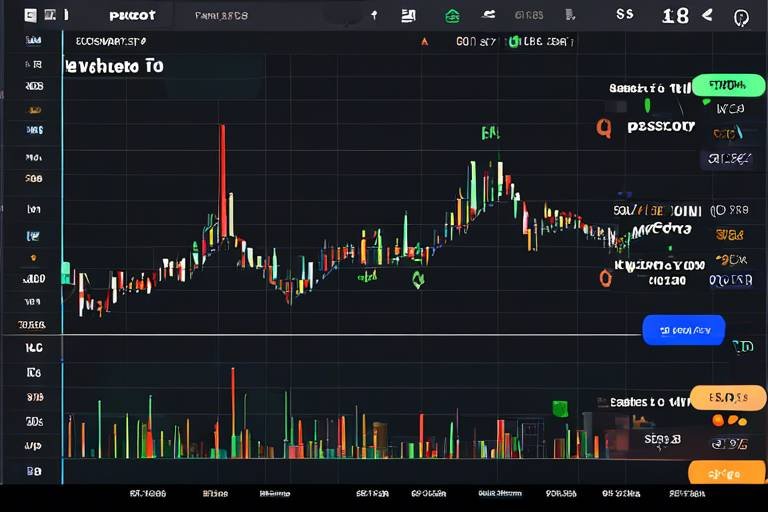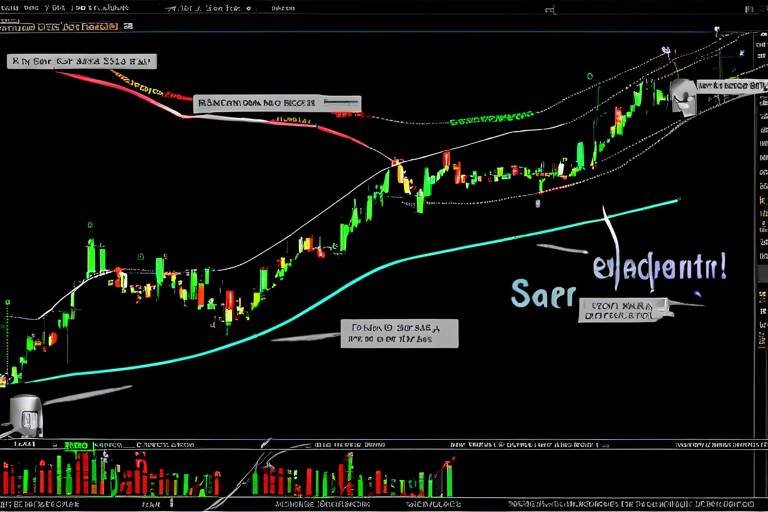The Impact of Market Sentiment on Technical Trading
Market sentiment is like the pulse of the financial world; it reflects the collective emotions and attitudes of investors towards a particular security or the market as a whole. When traders are feeling optimistic, they tend to buy more, driving prices up, which creates a bullish sentiment. Conversely, when fear and uncertainty take hold, selling pressure mounts, leading to a bearish sentiment that can cause prices to plummet. Understanding this psychological landscape is crucial for traders who rely on technical analysis to inform their strategies.
The interplay between market sentiment and technical trading strategies is fascinating. Think of it as a dance between numbers and emotions. Technical traders often look at charts and indicators to make decisions, but these tools do not exist in a vacuum. They are influenced by the mood of the market. For instance, a stock might be showing a strong bullish trend on the charts, but if the overall market sentiment turns negative due to external factors—like economic news or geopolitical events—traders may hesitate to act on those signals. This highlights the importance of integrating sentiment analysis into technical trading strategies.
Moreover, market sentiment can create self-fulfilling prophecies. When a significant number of traders believe a stock will rise, their buying action can drive the price up, reinforcing that belief. This phenomenon is often seen during market rallies, where positive sentiment feeds on itself, creating a momentum that can be hard to break. On the flip side, during market downturns, negative sentiment can lead to panic selling, which can push prices down further than the underlying fundamentals would suggest.
As we delve deeper into the nuances of market sentiment, it becomes clear that traders need to be not only skilled in technical analysis but also in understanding the emotional drivers behind market movements. This dual approach can significantly enhance their ability to predict market trends and make informed trading decisions. In the following sections, we will explore the role of emotions in trading, the various sentiment indicators available, and how emerging technologies are changing the landscape of technical trading.
- What is market sentiment?
Market sentiment refers to the overall attitude of investors toward a particular security or financial market, often categorized as bullish or bearish.
- How does fear affect trading?
Fear can lead to panic selling, causing prices to drop. Recognizing fear-driven trends can help traders identify potential buying opportunities.
- What are sentiment indicators?
Sentiment indicators are tools that measure the mood of the market, such as the Put/Call ratio or surveys of bullish and bearish sentiment.
- How can traders adapt to changing market sentiment?
Traders can remain agile and adjust their strategies based on shifts in market sentiment and technological advancements.

Understanding Market Sentiment
This article explores how market sentiment influences technical trading strategies, examining the psychological factors that drive traders' decisions and the overall market trends that arise from collective investor behavior.
Market sentiment refers to the overall attitude of investors toward a particular security or financial market. This sentiment can be categorized as either bullish, indicating optimism and a belief that prices will rise, or bearish, suggesting pessimism and a belief that prices will fall. Understanding this sentiment is crucial for traders because it shapes trading strategies and influences market movements. Just like the weather can dictate our daily activities, market sentiment can dictate how traders approach their investments.
When we talk about market sentiment, we’re really diving into the psychology of trading. Imagine a crowded room where everyone is talking about a new trend; the excitement can be contagious. Similarly, in financial markets, when investors are feeling optimistic, they tend to buy more, pushing prices higher. Conversely, when fear grips the market, it can lead to widespread selling, causing prices to plummet. Therefore, gauging the mood of the market is essential for anyone looking to make informed trading decisions.
Traders often rely on various tools and indicators to assess market sentiment. For example, they might look at social media trends, news headlines, or even the volume of trades. These indicators can provide a clearer picture of whether the market is leaning towards optimism or pessimism. Here’s a quick overview of some common sentiment indicators:
| Indicator | Description |
|---|---|
| Put/Call Ratio | Measures the volume of put options traded relative to call options, indicating market sentiment. |
| VIX Index | Also known as the "fear index," it gauges market volatility and investor fear. |
| Sentiment Surveys | Polls that measure investor sentiment, such as the AAII Sentiment Survey. |
Incorporating these indicators into trading strategies can significantly enhance decision-making. For example, if a trader notices a high Put/Call ratio, it may suggest that investors are feeling bearish, which could signal a potential buying opportunity if prices drop further. In essence, understanding market sentiment is like having a compass that guides traders through the unpredictable waters of financial markets.
Ultimately, being aware of market sentiment allows traders to position themselves advantageously. Whether they’re riding the wave of bullish enthusiasm or cautiously navigating through bearish tides, a solid grasp of sentiment can make all the difference between a successful trade and a missed opportunity.
- What is market sentiment? Market sentiment refers to the overall attitude of investors toward a particular security or market, which can be either bullish or bearish.
- How can I gauge market sentiment? You can gauge market sentiment by using various indicators like the Put/Call ratio, VIX index, and sentiment surveys.
- Why is market sentiment important in trading? Understanding market sentiment helps traders anticipate price movements and make informed decisions based on collective investor behavior.

The Role of Emotions in Trading
When we think about trading, we often picture charts, indicators, and numbers dancing on a screen. But what if I told you that the most powerful force in trading isn't just technical analysis? It's the emotions that drive us as human beings. Yes, emotions like fear and greed play a significant role in the decisions traders make every day. Understanding these emotions can be the key to navigating the often-turbulent waters of the financial markets.
Imagine you're standing on the edge of a cliff, looking down at the ocean waves crashing against the rocks below. That feeling of fear can be paralyzing, right? In trading, fear often manifests as panic selling, where investors, gripped by anxiety, rush to offload their assets at any price. This emotional response can create a domino effect, leading to a rapid decline in prices. Recognizing when fear is influencing the market can be a golden opportunity for savvy traders. Instead of following the herd, they can identify potential buying opportunities during these market corrections.
On the flip side, we have greed. Picture a child in a candy store, eyes wide with excitement, wanting to grab everything in sight. That's how greed operates in the markets. It can lead traders to overbuy, pushing asset prices to unsustainable levels. This emotional high can create a false sense of security, making it challenging to see the warning signs of a market reversal. By understanding the implications of greed, traders can better anticipate when the market might be headed for a downturn, allowing them to adjust their positions accordingly.
So, how do traders identify these emotional signals? One effective method is through sentiment indicators. For instance, the VIX index, often referred to as the "fear index," measures market volatility and can provide insights into prevailing fear levels. Similarly, the Put/Call ratio can indicate whether traders are leaning toward fear or greed. By keeping an eye on these indicators, traders can better understand the emotional landscape of the market and make more informed decisions.
Incorporating these emotional factors into trading strategies isn't just about avoiding losses; it's about enhancing overall performance. By aligning their strategies with the prevailing market sentiment, traders can increase their chances of success. The key is to remain vigilant, recognizing that emotions can cloud judgment and lead to costly mistakes. Remember, a calm mind often leads to better trading decisions.
As we look to the future, the ability to manage emotions in trading will become even more critical. With the rise of technology, traders will have access to advanced tools that can help them analyze sentiment more effectively. This evolution will empower traders to adapt their strategies in real-time, ensuring they stay ahead of the curve in an ever-changing market landscape.
- How can I control my emotions while trading? One effective way to manage emotions is to establish a solid trading plan and stick to it. Setting clear entry and exit points can help reduce impulsive decisions driven by fear or greed.
- What are some common emotional pitfalls traders face? Common pitfalls include overtrading due to excitement, panic selling during market dips, and holding onto losing positions out of fear of realizing a loss.
- Can technical analysis help in managing emotions? Yes, technical analysis provides a structured approach to trading, which can help reduce emotional decision-making. By focusing on data and indicators, traders can make more objective choices.

Fear and Its Effects
Fear is a powerful emotion that can grip even the most seasoned traders. When the market takes a downturn, fear often sets in, leading to what we call "panic selling." This phenomenon can cause a cascade of selling pressure, driving prices down even further. Imagine a crowded theater where someone yells "fire!"—the chaos that ensues can lead to irrational decisions. In trading, this can mean selling off assets at a loss simply to avoid further declines. Recognizing the signs of fear in the market is crucial for traders who want to turn panic into opportunity.
One of the most significant effects of fear is the sudden drop in asset prices. When traders collectively decide to sell, it creates a downward spiral that can lead to market corrections. These corrections, while often painful in the short term, can also present unique buying opportunities for savvy traders. By identifying fear-driven trends, traders can position themselves to buy at lower prices, capitalizing on the market's emotional state.
To help illustrate this point, consider the following table that outlines the relationship between fear in the market and potential trading opportunities:
| Market Condition | Trader Reaction | Potential Opportunity |
|---|---|---|
| Market Decline | Panic Selling | Buying at Lower Prices |
| Increased Volatility | Fear of Loss | Short Selling Opportunities |
| Market Recovery | Reluctance to Buy | Entry Before Full Recovery |
Moreover, traders can utilize various indicators to gauge the level of fear in the market. One popular tool is the VIX index, often referred to as the "fear index." This measure reflects market volatility and can provide insights into how fearful investors are feeling. When the VIX rises, it typically indicates heightened fear, signaling traders to reassess their positions. By staying attuned to these fear signals, traders can adjust their strategies accordingly, potentially profiting from market corrections while others are paralyzed by fear.
In summary, understanding fear and its effects is vital for any trader. By recognizing fear-driven trends and utilizing sentiment indicators, traders can navigate the turbulent waters of the market with greater confidence. Instead of succumbing to panic, they can seize opportunities that arise from collective emotional responses, turning fear into a strategic advantage.
- What is the VIX index?
The VIX index measures market volatility and is often used as an indicator of fear in the market. A higher VIX indicates greater fear among investors.
- How can I identify fear-driven trends?
Traders can look for sharp declines in stock prices, increased trading volume, and rising volatility indices like the VIX to identify fear-driven trends.
- What are market corrections?
Market corrections are temporary declines in asset prices, typically defined as a drop of 10% or more from recent highs. They can provide buying opportunities for traders.

Market Corrections
Market corrections are those inevitable moments when the financial markets take a breather, often leading to temporary price declines of 10% or more from recent highs. Think of it like a runner who, after sprinting at full speed, needs to slow down and catch their breath. These corrections serve as a natural part of market dynamics, allowing for the recalibration of prices based on current economic realities and investor sentiment. While they can be unsettling for many, savvy traders recognize these periods as golden opportunities to enter the market at favorable prices.
During a correction, the prevailing sentiment often shifts from bullish enthusiasm to a more cautious or bearish outlook. This shift can be driven by various factors, including economic data releases, geopolitical events, or even shifts in market psychology. For instance, if a highly anticipated earnings report falls short of expectations, it might trigger a wave of selling, leading to a correction. However, understanding that these fluctuations are a normal part of market behavior can help traders maintain a level head and make more rational decisions.
Moreover, market corrections can reveal underlying strengths or weaknesses in specific sectors or stocks. For example, if a tech stock experiences a correction but shows resilience compared to its peers, it may indicate strong fundamentals and potential for recovery. Traders who can identify such trends during corrections can position themselves advantageously, buying stocks that are temporarily undervalued due to market overreactions.
In addition to recognizing the opportunity presented by corrections, traders can utilize various tools and indicators to aid their decision-making process. Here’s a quick overview of some common approaches:
- Technical Indicators: Tools like moving averages can help identify support levels during corrections.
- Volume Analysis: Increased trading volume during a correction may signal stronger conviction in price movements.
- Sentiment Indicators: Analyzing sentiment can provide insights into whether the market is overreacting or if a correction is justified.
Ultimately, navigating market corrections requires a blend of emotional intelligence and analytical skills. Traders who can keep their emotions in check, while simultaneously leveraging data and sentiment analysis, are likely to emerge from corrections with significant gains. Remember, the key is not to fear the correction but to embrace it as a chance to recalibrate your trading strategy and enhance your portfolio.
Q: What causes market corrections?
A: Market corrections can be triggered by various factors, including economic data releases, geopolitical events, or changes in investor sentiment.
Q: How long do market corrections typically last?
A: Corrections can vary in duration, but they generally last from a few days to several months, depending on the underlying market conditions.
Q: Should I sell my investments during a market correction?
A: It depends on your investment strategy. Some traders see corrections as buying opportunities, while others may choose to take profits or cut losses.
Q: How can I identify a market correction?
A: A correction is typically identified when a market experiences a decline of 10% or more from its recent peak.

Identifying Fear Signals
Identifying fear signals in the market is crucial for traders looking to navigate the unpredictable waters of trading. Fear can manifest in various ways, and recognizing these signals can provide valuable insights into market sentiment. One of the most effective tools for gauging fear is the VIX index, often referred to as the "fear gauge." This index measures the market's expectation of volatility based on S&P 500 index options. When the VIX rises, it typically indicates that investors are anticipating increased volatility and are feeling anxious about potential market downturns.
Additionally, traders should pay attention to volume spikes and sudden price drops, which can signal panic selling. When many investors sell off their holdings simultaneously, it can create a snowball effect, leading to further declines in prices. This behavior often stems from a collective fear of loss, prompting traders to act quickly to avoid further losses. By monitoring these patterns, traders can better position themselves to capitalize on potential buying opportunities during market corrections.
Another useful approach to identifying fear signals is through sentiment surveys, such as the American Association of Individual Investors (AAII) Sentiment Survey. This survey measures the sentiment of individual investors, revealing whether they are feeling bullish or bearish. A high percentage of bearish sentiment can indicate widespread fear in the market, suggesting that a reversal may be on the horizon. Understanding these indicators allows traders to make more informed decisions and adjust their strategies accordingly.
To summarize, here are some key indicators to watch for when identifying fear signals:
- Rising VIX index: Indicates increased market volatility and investor fear.
- Volume spikes: Sudden increases in trading volume can signal panic selling.
- Sentiment surveys: Tools like the AAII Sentiment Survey can provide insights into investor attitudes.
By keeping a close eye on these indicators, traders can better navigate the turbulent waters of the market and potentially find lucrative entry points during periods of fear-driven corrections. This proactive approach to identifying fear signals not only enhances trading strategies but also empowers traders to stay ahead in a fast-paced trading environment.
Q: What is the VIX index and why is it important?
A: The VIX index measures the market's expectation of volatility based on S&P 500 options. It's important because it serves as a gauge of market sentiment, particularly fear, helping traders anticipate potential market movements.
Q: How can I use sentiment surveys in my trading strategy?
A: Sentiment surveys provide insights into the collective mood of investors. By analyzing these surveys, traders can identify potential market reversals or confirm existing trends, allowing them to make more informed trading decisions.
Q: What should I do if I identify fear signals in the market?
A: If you identify fear signals, consider adjusting your trading strategy. This could mean looking for buying opportunities during corrections or tightening your stop-loss orders to protect your capital.

Greed and Its Implications
Greed, often referred to as the "silent killer" in trading, can be a double-edged sword. On one hand, it drives investors to seek higher returns, pushing them to buy into assets that are trending upwards. On the other hand, it can lead to irrational decision-making, resulting in overbuying and inflated asset prices. This phenomenon occurs when traders become overly optimistic, convinced that the market will continue to rise indefinitely. But just like a balloon that has been inflated too much, eventually, it will pop!
When greed takes hold, it can create a false sense of security among traders. They may ignore fundamental analysis and the underlying value of the assets they are purchasing, focusing solely on the potential for profit. This behavior often leads to market bubbles, where prices soar far beyond their intrinsic value. As these bubbles grow, they attract more investors, creating a herd mentality that can be difficult to escape. Unfortunately, when the bubble bursts, those same investors are left holding assets that have plummeted in value.
Understanding the implications of greed is crucial for any trader. Here are some key points to consider:
- Market Reversals: Greed-driven behavior can often signal that a market reversal is imminent. When prices reach unsustainable levels, a correction is likely to follow.
- Overvaluation: Traders must be cautious of overvalued assets. It's essential to perform due diligence and not get swept away by the excitement of rising prices.
- Risk Management: Implementing strict risk management strategies can help mitigate the effects of greed. Setting stop-loss orders and taking profits at predetermined levels can protect traders from significant losses.
To navigate the treacherous waters of trading influenced by greed, it's vital for traders to maintain a level-headed approach. Regularly revisiting their trading plans and sticking to their strategies can help them avoid falling into the trap of emotional trading. Additionally, staying informed about market conditions and understanding the psychological factors at play can empower traders to make more rational decisions.
In conclusion, while greed can drive profits in the short term, it is essential to recognize its potential to lead to devastating losses. By understanding its implications and maintaining discipline, traders can harness the power of greed without letting it dictate their trading strategies.
- What is market sentiment? Market sentiment is the overall attitude of investors toward a particular security or financial market, which can significantly influence trading strategies.
- How does fear affect trading decisions? Fear can lead to panic selling, causing prices to drop. Recognizing fear-driven trends can help traders identify potential buying opportunities.
- What are sentiment indicators? Sentiment indicators, such as the Put/Call ratio and Bullish/Bearish sentiment surveys, provide valuable data on market sentiment, assisting traders in making informed decisions.
- How can traders combine sentiment analysis with technical signals? By integrating sentiment analysis with traditional technical signals, traders can align their positions with prevailing market psychology for better outcomes.

Technical Analysis and Sentiment Indicators
When it comes to trading, the art of technical analysis is often intertwined with the science of market sentiment. Traders who rely solely on charts and historical price data may miss out on crucial insights that sentiment indicators provide. These indicators serve as a window into the collective psyche of the market, revealing the emotions and attitudes that drive investor behavior. By understanding sentiment, traders can enhance their technical analysis, leading to more informed decisions and potentially more profitable outcomes.
Sentiment indicators can be categorized into two main types: market sentiment indicators and trader sentiment indicators. Market sentiment indicators, such as the Put/Call ratio and volatility indexes, reflect the overall mood of the market. For instance, a high Put/Call ratio may indicate bearish sentiment, suggesting that traders are hedging against potential declines. On the other hand, trader sentiment indicators, like surveys that gauge investor optimism or pessimism, provide insights into how individual traders feel about the market. These indicators can be powerful tools for predicting market movements, as they often signal potential reversals or continuations in trends.
Integrating sentiment analysis with traditional technical signals can be a game-changer for traders. For example, if a trader notices that a stock is approaching a significant support level while sentiment indicators are showing extreme fear, it may signal a buying opportunity. Conversely, if a stock is hitting a resistance level amidst overwhelming bullish sentiment, it could be a red flag for a potential reversal. This combination of technical analysis and sentiment indicators allows traders to align their positions with the prevailing market psychology, making their strategies more robust.
To illustrate the importance of sentiment indicators in technical analysis, consider the following table:
| Indicator | Type | Usage |
|---|---|---|
| Put/Call Ratio | Market Sentiment | Indicates bearish or bullish sentiment based on options trading |
| VIX Index | Market Sentiment | Measures market volatility and investor fear |
| AAII Sentiment Survey | Trader Sentiment | Gauges individual investor sentiment towards the market |
| Consumer Confidence Index | Trader Sentiment | Reflects overall consumer sentiment and its potential impact on the market |
In summary, blending technical analysis with sentiment indicators creates a more comprehensive trading strategy. It allows traders to not only rely on historical price movements but also to consider the emotional aspects of the market. As the trading landscape continues to evolve, understanding and utilizing sentiment indicators will be crucial for traders who wish to stay ahead of the curve.
- What are sentiment indicators? Sentiment indicators are tools used to gauge the overall mood of the market, reflecting the emotions and attitudes of investors.
- How can I use sentiment indicators in my trading strategy? By integrating sentiment analysis with technical signals, traders can identify potential market reversals or continuations, enhancing their decision-making process.
- What is the Put/Call ratio? The Put/Call ratio measures the volume of put options traded relative to call options, indicating whether traders are more bearish or bullish on the market.
- Why is understanding market sentiment important? Understanding market sentiment helps traders anticipate market movements and adjust their strategies accordingly, leading to potentially more profitable trades.

Sentiment Indicators Explained
When it comes to trading, understanding the pulse of the market is crucial. This is where sentiment indicators come into play. These tools provide traders with a snapshot of how other investors are feeling about a particular security or the market as a whole. Think of them as the emotional barometers of the financial world, helping you gauge whether the collective mood is optimistic or pessimistic. By analyzing these indicators, traders can make more informed decisions, aligning their strategies with prevailing market sentiments.
One of the most commonly used sentiment indicators is the Put/Call Ratio. This ratio compares the volume of put options (which investors buy when they expect a price decline) to call options (which are purchased when they anticipate a price increase). A high Put/Call ratio may indicate that investors are feeling bearish, while a low ratio suggests bullish sentiment. This simple yet powerful tool can help traders identify potential market reversals. For example, if the Put/Call ratio spikes significantly, it might signal an overabundance of fear, presenting a potential buying opportunity.
Another valuable sentiment indicator is the Bullish/Bearish Sentiment Survey. This survey, often conducted by financial news outlets or trading platforms, asks investors whether they believe the market will go up or down over a certain period. The results can shed light on the overall sentiment. If a majority of respondents are bullish, it may indicate a crowded trade that could lead to a market pullback. Conversely, if bearish sentiment prevails, it might suggest that a rally is on the horizon as pessimism could be overextended.
Here's a quick look at some popular sentiment indicators:
| Indicator | Description | What It Indicates |
|---|---|---|
| Put/Call Ratio | Compares the volume of put options to call options. | High Bearish sentiment; Low Bullish sentiment. |
| Bullish/Bearish Sentiment Survey | Surveys asking investors about their market outlook. | Majority Bullish Potential pullback; Majority Bearish Possible rally. |
| VIX Index | Measures market volatility and investor fear. | High Increased fear; Low Confidence in market stability. |
By integrating these sentiment indicators into their trading strategies, investors can better navigate the complexities of the market. However, it’s essential to remember that no indicator is foolproof. Market sentiment can shift rapidly, influenced by news events, economic data releases, and even social media trends. Therefore, combining sentiment analysis with traditional technical analysis can provide a more comprehensive view of market dynamics.
In conclusion, sentiment indicators serve as valuable tools in a trader's arsenal. They offer insights into market psychology, allowing traders to make more informed decisions. By keeping an eye on these indicators, you can enhance your trading strategies and potentially improve your outcomes in the ever-fluctuating world of finance.
- What are sentiment indicators? Sentiment indicators are tools used to gauge the overall mood of investors towards a particular security or market.
- How do I use sentiment indicators in trading? You can incorporate sentiment indicators into your trading strategy by analyzing them alongside traditional technical analysis to make informed decisions.
- Are sentiment indicators always reliable? While they provide valuable insights, sentiment indicators are not foolproof and should be used in conjunction with other analysis methods.

Combining Sentiment with Technical Signals
In the world of trading, combining sentiment analysis with technical signals can be a game-changer. Imagine trying to navigate a vast ocean without a compass; that’s how traders feel when they rely solely on one approach. By integrating both sentiment and technical indicators, traders can create a more comprehensive strategy that allows them to ride the waves of market fluctuations with greater confidence.
Technical signals, such as moving averages, support and resistance levels, and chart patterns, provide a framework for understanding price movements. However, when these signals are viewed through the lens of market sentiment, they can reveal deeper insights. For instance, if a stock is trading near a significant resistance level but sentiment indicators show overwhelming bullishness, it may signal a potential breakout rather than a reversal.
Consider the following key components when combining sentiment with technical signals:
- Volume Analysis: High trading volume accompanying a price movement can indicate strong sentiment. For example, if a stock surges with high volume, it suggests that many traders are buying into the momentum, reinforcing the technical signal.
- Sentiment Indicators: Utilize tools like the Put/Call ratio or sentiment surveys to gauge the market's mood. If the sentiment is overly bullish while technical indicators suggest overbought conditions, it could be a warning sign of a potential pullback.
- Market Trends: Always keep an eye on broader market trends. If the overall market sentiment is bearish, even a strong technical signal on a particular stock may not hold. The market's collective mood can often overpower individual stock movements.
By weaving together sentiment and technical signals, traders can enhance their decision-making process. For instance, a trader might observe that a stock is approaching a key support level while the sentiment is turning bullish. This convergence can serve as a powerful indicator to enter a long position. Conversely, if a stock is nearing a resistance level amidst widespread bullish sentiment, it might be wise to consider taking profits or setting stop-loss orders.
In essence, the combination of sentiment and technical analysis acts like a finely tuned instrument, allowing traders to fine-tune their strategies. It’s about finding harmony between the numbers and the emotions that drive the market. As traders become more adept at interpreting these signals together, they can seize opportunities that others might overlook, ultimately leading to more successful trading outcomes.
Q1: How do I start incorporating sentiment analysis into my trading strategy?
A1: Begin by familiarizing yourself with various sentiment indicators, such as the Put/Call ratio or sentiment surveys. Monitor these indicators alongside your technical analysis to gain a more rounded view of the market.
Q2: Can sentiment analysis help predict market reversals?
A2: Yes, sentiment analysis can provide clues about potential market reversals. For instance, extreme bullish or bearish sentiment often precedes corrections as traders react to overvaluation or panic.
Q3: Are there any tools available for sentiment analysis?
A3: Many trading platforms and financial news websites offer sentiment analysis tools. Look for features that provide real-time sentiment data, such as social media sentiment trackers or market sentiment reports.

The Future of Technical Trading
The landscape of technical trading is rapidly evolving, and the future promises an even more dynamic environment for traders. As technology continues to advance, the integration of sentiment analysis into trading platforms is becoming increasingly prevalent. This shift not only enhances the ability of traders to interpret market movements but also provides them with a competitive edge in an ever-changing financial landscape.
One of the most exciting developments on the horizon is the rise of artificial intelligence (AI) and machine learning technologies. These innovations are revolutionizing how traders analyze market sentiment. By leveraging vast amounts of data, AI can identify patterns and trends that may not be immediately apparent to human traders. This capability allows for more informed decision-making, as traders can anticipate market shifts before they occur. Imagine having a virtual assistant that not only tracks your trades but also predicts the next big move in the market based on sentiment analysis!
Moreover, as more traders adopt these advanced technologies, the market itself may become more efficient. The collective behavior of traders influenced by sentiment analysis could lead to more predictable market trends. However, this also means that traders must remain agile and adaptable. The ability to pivot strategies in response to changing sentiment will be crucial for success. After all, in a world where technology is constantly evolving, sticking to outdated strategies could spell disaster.
To illustrate the potential impact of sentiment analysis on trading strategies, consider the following table:
| Aspect | Traditional Trading | Future Trading with Sentiment Analysis |
|---|---|---|
| Data Analysis | Manual analysis of charts and indicators | AI-driven analysis with real-time sentiment tracking |
| Decision-Making Speed | Slower, based on personal judgment | Faster, driven by algorithmic recommendations |
| Market Adaptability | Rigid strategies | Dynamic strategies that adjust to sentiment shifts |
As we look to the future, it's clear that understanding market sentiment will become essential for traders. The ability to read the emotional pulse of the market will not only inform trading strategies but also enhance risk management practices. For instance, a trader who can discern when fear is driving the market may choose to hold off on selling during a panic, recognizing that prices may rebound as sentiment shifts back to optimism.
In conclusion, the future of technical trading is bright, fueled by technological advancements and a deeper understanding of market psychology. Traders who embrace these changes and adapt their strategies accordingly will likely find themselves at the forefront of the trading revolution. So, are you ready to ride the wave of the future?
- What is sentiment analysis in trading? - Sentiment analysis involves evaluating the overall mood of the market, typically gauged through investor emotions and behaviors, to inform trading decisions.
- How does AI impact technical trading? - AI enhances technical trading by providing faster data analysis, identifying trends, and offering predictive insights that can inform trading strategies.
- What should traders focus on in the future? - Traders should focus on integrating sentiment analysis into their strategies, staying adaptable to market changes, and leveraging new technologies like AI.

Emerging Technologies
In today's fast-paced trading environment, are revolutionizing how traders analyze and interpret market sentiment. With the advent of artificial intelligence (AI) and machine learning, traders can now leverage complex algorithms that sift through vast amounts of data, identifying patterns and sentiment shifts that were previously undetectable. Imagine having a personal assistant that not only keeps track of your trades but also predicts market movements based on real-time sentiment analysis. Sounds futuristic, right? Well, it's happening now!
AI-driven tools are capable of analyzing social media feeds, news articles, and even financial reports to gauge public sentiment about particular stocks or the market as a whole. For instance, platforms like Sentiment Analysis APIs can process thousands of tweets or news headlines in seconds, providing traders with a comprehensive view of how investors feel about a certain asset. This capability allows traders to make more informed decisions that align with market psychology.
Another exciting development is the use of natural language processing (NLP), which enables machines to understand and interpret human language. This technology can analyze the tone of discussions in forums, blogs, and social media, offering insights into the prevailing sentiment among retail investors. By integrating this data with traditional technical indicators, traders can enhance their strategies, ensuring they are not just reacting to price movements but also to the underlying emotions driving those movements.
Moreover, the rise of big data analytics has given traders access to an unprecedented wealth of information. With the ability to analyze historical data alongside current sentiment, traders can identify correlations and trends that inform their trading strategies. For example, a trader might notice that a particular stock tends to rise after a certain volume of positive sentiment is expressed on social media. This knowledge can be invaluable in timing entries and exits in the market.
As we look to the future, it’s clear that staying ahead of the curve will require traders to embrace these technologies. The integration of AI and machine learning into trading platforms is not just a trend; it's becoming a necessity. Traders who adapt to these changes will find themselves with a competitive edge in an ever-evolving landscape. The future of technical trading is bright, and those willing to harness the power of emerging technologies will undoubtedly reap the rewards.
- What are the main benefits of using AI in trading? AI can analyze vast amounts of data quickly, identify trends, and provide insights that human traders might miss.
- How does sentiment analysis influence trading decisions? By understanding market sentiment, traders can make more informed decisions that align with the collective mood of investors.
- What role does machine learning play in technical trading? Machine learning algorithms can learn from historical data and improve their predictions over time, enhancing trading strategies.
- Can emerging technologies replace human traders? While technologies can assist traders, human intuition and experience remain crucial in navigating complex market dynamics.

Adapting to Market Changes
In the fast-paced world of trading, adaptability is not just a skill; it's a survival mechanism. Markets are constantly shifting, influenced by a myriad of factors such as economic indicators, geopolitical events, and even social media trends. As a trader, being able to pivot your strategies in response to these changes can mean the difference between profit and loss. Think of the market as a river: sometimes it flows smoothly, and other times it churns with unexpected currents. If you don’t adjust your course, you risk capsizing your trading boat.
One of the most effective ways to stay ahead is by closely monitoring market sentiment. This involves keeping an ear to the ground to hear the whispers of fear and greed that echo through trading floors and online forums. By understanding the emotional undercurrents driving market behavior, traders can position themselves strategically. For instance, during a bullish phase, when optimism is rampant, it might be tempting to join the frenzy. However, a savvy trader knows to watch for signs of overextension and potential reversals.
Moreover, incorporating technological tools can significantly enhance your ability to adapt. With the rise of AI and machine learning, traders now have access to sophisticated algorithms that analyze vast amounts of data in real-time. These tools can identify patterns and trends that may not be immediately apparent to the naked eye. For example, a trader might use sentiment analysis software to gauge public sentiment on social media regarding a specific stock. If the sentiment suddenly shifts from positive to negative, it may indicate an impending drop in price, allowing the trader to exit their position before significant losses occur.
Additionally, it's crucial to develop a flexible trading plan. This plan should not be set in stone but rather be a living document that evolves as market conditions change. Regularly reviewing and adjusting your strategy based on current market sentiment can help you stay aligned with the prevailing trends. Consider creating a
| Date | Market Sentiment | Action Taken | Outcome |
|---|---|---|---|
| 01/01/2023 | Bullish | Increased position in Tech stocks | Profited 15% |
| 01/15/2023 | Bearish | Sold off high-risk assets | Avoided losses |
| 02/01/2023 | Neutral | Held existing positions | Stable returns |
Finally, never underestimate the power of community and networking. Engaging with other traders can provide invaluable insights into how others are adapting to market changes. Online forums, social media groups, and trading seminars are excellent platforms to share experiences and strategies. Remember, trading can be a lonely endeavor, but you don’t have to go it alone. By collaborating and exchanging ideas, you can enhance your understanding of market sentiment and refine your approach.
- What is market sentiment? Market sentiment refers to the overall attitude of investors towards a particular security or financial market, which can be bullish (optimistic) or bearish (pessimistic).
- How can I measure market sentiment? You can measure market sentiment using various indicators such as the Put/Call ratio, sentiment surveys, and even social media analytics.
- Why is adapting to market changes important? Adapting to market changes is crucial because it allows traders to make informed decisions that can help maximize profits and minimize losses in a volatile environment.
- What tools can help with adaptation? Tools like AI sentiment analysis software, trading journals, and performance tracking tables can significantly aid in adapting strategies to changing market conditions.
Frequently Asked Questions
- What is market sentiment and why is it important?
Market sentiment is the overall attitude of investors toward a particular security or financial market. It can be bullish (positive) or bearish (negative). Understanding market sentiment is crucial because it influences trading strategies and can lead to significant price movements based on collective investor behavior.
- How do emotions like fear and greed affect trading?
Emotions play a pivotal role in trading decisions. Fear can lead to panic selling, causing prices to drop, while greed can result in overbuying and inflated asset prices. By recognizing these emotional trends, traders can better navigate market fluctuations and make more informed decisions based on sentiment analysis.
- What are market corrections and how can traders benefit from them?
Market corrections are temporary price declines that can present buying opportunities for traders. By understanding the prevailing market sentiment during these corrections, traders can enter positions at lower prices, potentially capitalizing on the market's recovery.
- What are sentiment indicators and how are they used in trading?
Sentiment indicators are tools that gauge market psychology, such as the Put/Call ratio and Bullish/Bearish sentiment surveys. These indicators provide valuable insights into potential price movements, assisting traders in refining their strategies and making informed decisions based on market sentiment.
- How can combining sentiment analysis with technical signals improve trading outcomes?
Integrating sentiment analysis with traditional technical signals allows traders to align their positions with prevailing market psychology. This combination can enhance trading strategies, leading to better outcomes and improved decision-making in dynamic market conditions.
- What role will emerging technologies play in the future of technical trading?
Emerging technologies, including AI and machine learning, are set to revolutionize how traders analyze sentiment. These innovations will provide deeper insights into market behavior, enhancing decision-making processes and helping traders stay ahead in an ever-evolving trading landscape.
- How can traders adapt to changing market sentiments?
To maintain a competitive edge, traders must remain agile and adapt their strategies in response to shifting market sentiments and technological advancements. This adaptability is key to navigating the complexities of modern trading environments effectively.



















